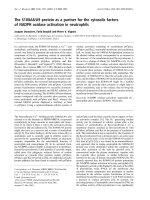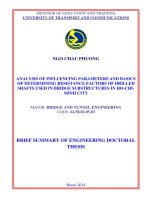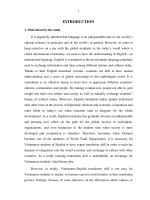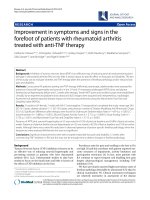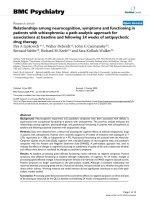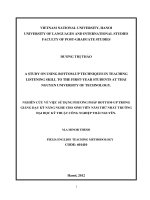DEPRESSIVE SYMPTOMS AND RELATED FACTORS OF THE GENERAL MEDICAL STUDENT AT HAI PHONG UNIVERSITY OF MEDICINE AND PHARMACY IN 2016
Bạn đang xem bản rút gọn của tài liệu. Xem và tải ngay bản đầy đủ của tài liệu tại đây (555.29 KB, 78 trang )
`MINISTRY OF HEALTH MINISTRY OF EDUCATION AND TRAINING
HAI PHONG UNIERSITY OF MEDICINE AND PHARMACY
NGUYEN THI MO
DEPRESSIVE SYMPTOMS AND RELATED FACTORS
OF THE GENERAL MEDICAL STUDENT
AT HAI PHONG UNIVERSITY OF MEDICINE AND
PHARMACY IN 2016
GRADUATE THESIS OF
PREVENTIVE MEDICINE DOCTOR
HAI PHONG 6/2016
`MINISTRY OF HEALTH MINISTRY OF EDUCATION AND TRAINING
HAI PHONG UNIERSITY OF MEDICINE AND PHARMACY
NGUYEN THI MO
DEPRESSIVE SYMPTOMS AND RELATED FACTORS
OF THE GENERAL MEDICAL STUDENT
AT HAI PHONG UNIVERSITY OF MEDICINE AND
PHARMACY IN 2016
Majors: Preventive Medicine Doctor
Code :
GRADUATE THESIS OF PREVENTIVE MEDICINE DORTOR
Thesis Advisors: 1. Master. Nguyen Thi Minh Ngoc
2. Master. Nguyen Thi Thu Thao
HAI PHONG 6/2016
DECLARATION
I am sure that this graduate thesis is my own study; all investigated data
and researching results which are actually honest and logical, have never been
published in other research projects.
NGUYEN THI MO
ACKNOWLEDGMENT
I would like to express my sincere gratitude:
The Rector Board and Department of Undergraduate Education, Hai
Phong University of Medicine and Pharmacy
The Chairmen Board and lecturers of the Department of Public Health
at Hai Phong University of Medicine and Pharmacy dedicatedly instructed
me to study and complete my thesis.
Meanwhile, the training University department assists me to collect
accurate and reliable data particularly.
I would like to express my faithful thanks to Master Nguyen Thi Minh
Ngoc and Nguyen Thi Thu Thao, who spent a lot of their time on
instructing me for my thesis.
I sincerely thank Mr. Ha Van Truong, the lecturer at the Ha Truong
English center guided, instructed and prompted me in English language.
My family and friends always encourage and support me to study and
complete my thesis.
Hai Phong, 25/5/2016
Author
Nguyen Thi Mo
ABBREVIATIONS
CES-D
C.I
WHO
The center for epidemiologic studies depression scale
Confidence interval
The World Health Organization
CONTENT
INTRODUCTION.................................................................................................................................1
CHAPTER 1.........................................................................................................................................3
Literature review...............................................................................................................................3
1.1. Concepts of depression...............................................................................................3
1.3. Risk factors and consequences of depression in medical students....................11
1.4. Depression measurement..........................................................................................14
CHAPTER 2.......................................................................................................................................17
METHODOLOGY...............................................................................................................................17
2.1. Study subjects.............................................................................................................17
2.2. Study location ...........................................................................................................17
2.3. Study time...................................................................................................................17
2.4. Methodology...............................................................................................................17
2.5. Data processing and analysis...................................................................................21
2.6. Ethical study...............................................................................................................22
CHAPTER 3.......................................................................................................................................23
RESULT............................................................................................................................................23
3.1. Description of general characteristics....................................................................23
3.2. Students have depressive symptoms based on the CES-D scale........................26
3.3. Depressive symptoms and related factors.............................................................29
DISCUSSION.....................................................................................................................................38
4.1. The general characteristics and depressive symptom of the study subjects ...38
4.2. Related factors to depressive symptoms of general medical students at Hai
Phong University of Medicine and Pharmacy, 2015 – 2016.......................................42
CONCLUSION...................................................................................................................................53
RECOMMENDATION........................................................................................................................55
REFERENCES......................................................................................................................................1
QUESTIONNAIRE................................................................................................................................5
Part C: Stressful life events..............................................................................................................10
LIST OF TABLE
Table 2.1: Distribution of the sample size in grade
Table 2.2: Variables and index measurement
Table 3.1: Distribution of subject by religion and year in course
Table 3.2: Distribution of subject by parents’ education
Table 3.3: Distribution of subject by current residence
Table 3.4: Positive signs according to the CES-D
Table 3.5: Difficulty in communication signs based on the CES-D
Table 3.6: Depressed signs based on the CES-D
Table 3.7: Active selves signs according to the CES-D
Table 3.8: The relationship between depressive symptom and grade
Table 3.9: The relationship between depressive symptom and gender
Table 3.10: The relationship between depressive symptom and religion
Table 3.11: The relationship between depressive symptom and current
19
20
25
27
28
29
29
30
31
33
34
34
35
residence
Table 3.12: The relationship between depressive symptom and parents’
36
marital status
Table 3.13: The relationship between depressive symptom and family
38
residence
Table 3.14: The relationship between friends, society and depressive
38
symptom
Table 3.15: The relationship between the family factors and depressive
40
symptom
Table 3.16: The relationship between depressive symptom and
41
interpersonal sources
Table 3.17: The relationship between the study- related factors and
42
depressive symptom
LIST OF FIGURES
Figure 1.1: Proposed model of causes and consequences of student
15
distress
Figure 3.1: Distribution of subject by gender
Figure 3.2: Distribution of subject by ethnicity and course
Figure 3.3: Distribution of subject by family residence
Figure 3.4: Percentage of depressive symptom among the students
25
26
27
32
1
INTRODUCTION
Depression is now becoming one of the most serious mental health
issues and social problems in many countries and trending to increase in the
next 20 years [31]. Depressive symptoms are widely distributed in the
population and disrupt people’s normal life.
According to World Health Organization (2012), depression is a
significant contributor to the global burden of disease with an estimated 350
million people in all communities across the world affected [37]. Moreover,
every year, approximately 5% of the world population have depression
[36]. WHO predicts that by 2020 depression will be the second cause of loss
of working second in the world [37]. Depression results from a complex
interaction of social psychological and biological factors. Especially, when
long-lasting and with moderate or severe intensity, depression can lead to lead
to more stress and dysfunction, worsen the affected person’s life situation. At
its worst, depression can lead to suicide. Within about 1 million cases die per
year in the world, the suicide is the second leading cause of death in the 15-29
age-group [37].
However, in Vietnam, a scientific awareness about depression is still
limited. "Feeling sad" has been seen as a normal shape of mood, not to be
considered as criteria for evaluating early signs of depression. The early
evaluation of depressive signs is an extremely important thing to prevent the
occurrence as well as to have effective treatment process for depression.
So far there have been few types of research on depressive symptoms in
Vietnamese
people
as
well
as
students,
especially
on
medical
students. Students have to experience numerous challenges including
exploring or developing their identity, navigating the transition from a state of
2
full dependence on a state of semi-dependence on parents, creating the social
relationship, managing the finance, leaving their primary support system... In
addition, medical students have to spend a long time on training with huge
knowledge and high pressure to become good doctors. Previous studies have
suggested that medical students have many high-risk factors of depression
[24, 33, 13]. The prevalence of depressive symptoms in American and
Canadian medical students was 15% and 19% [8]. Seriously, as a
consequence, the rate of medical students with suicidal intention is increasing
rapidly. Blum R showed 20% of medical students in Asia had thought of
suicide, including 8,4% of students with deliberate suicide in a study
[8]. They are evidence of the burden of mental health, problems of young
people, especially medical students. It will lead to long-term consequences
with the impact on a future career. Therefore, early detection of depressive
symptoms in medical students will help to make efficacious and costeffective treatment as well as to prevent the serious consequences caused by
depression. Because of this reason we conducted the study: "Depressive
symptoms and related factors of general medical students at Hai Phong
University of Medicine and Pharmacy, 2016" with two objectives:
1. To examine the percentage of depressive symptom of general
medical students at Hai Phong University of Medicine and pharmacy,
academic year 2015-2016.
2. To determine some related factors to depressive symptoms of general
medical students at Hai Phong University of Medicine and Pharmacy,
academic year 2015-2016.
3
CHAPTER 1
LITERATURE REVIEW
1.1. Concepts of depression
1.1.1. Concepts
Based on the World Health Organization (WHO): "Depression is a
common mental disorder, characterized by sadness, loss of interest and
pleasure, feelings of guilt, underestimate the value itself, sleeplessness, loss of
appetite, fatigue and poor concentration" [36].
Depression may persist or recur, weaken the ability to activate at work,
school or daily life. The most severe, depression can lead to suicide. If the
disease is mild, people can be treated without medication, if moderate or
severe depression, the patient needs medication and treatments with
psychological [36].
According to Nguyen Minh Tuan [10], depression is a state of
emotional turmoil, it has the following characteristics:
-
Sadness organisms (boundless mental suffering)
Inhibition of thinking and working (slowly, dementia)
Sleep disturbances and the biological functions
The prognosis relates to suicide risk. This risk is present throughout the
course of the disease. Therefore, the patients should be monitored closely.
Regarding the formation of the depressive episode, the situation can
occur include:
-
Usually the insidious progression.
Sometimes a sudden (start by suicide).
Maybe after the next episode of mania.
After a trauma, mental or body (illness, retirement, mourning).
Perhaps because of medicinal disadvantage causes depression.
At the onset, the disease progresses slowly with the first signs of
insomnia, headaches, fatigue. After a few weeks or a few months, ability to
work, loss of self-worth, hesitation, indifference to work and family can be
4
seen working, in this way, patients are anxious about the health and future,
may have come to tendency to suicide.
During the entire development phase, symptoms can include:
motionless face, signs of suffering "depression Omega" (wrinkle when
frowning two eyebrows). Patients do not care about their appearance as
well. Patients almost are motionless, sitting in one place for several
hours. Not necessarily talking, being asked is answered reluctantly,
interspersed moans, sighing. More severe is not talking.
Some cases of patients try to hide disorders (fake smile). In this case,
suicide risk is high because of those around him not guard. From natural
disease may average 6-7 months later (short attacks are just a few weeks, long
attacks last many years). When being treated, episodes of illness may shorten
the average one month after hospitalization. The symptoms gradually
improved and sleep recovery. Patients are considered cured when the joy
comes back.
1.1.2. History of depression
So far, many scientists, researchers from many different specialties
have learned and studied about depression [1].
- In ancient times: The emotional disorders have been identified as a
disease; Saul described the symptoms, manifestations of depression.
- Bipolar disorder (called depression), formerly, known as the manic
psychosis- depression, was identified by the physician and philosopher of
Greek, particularly Hippocrates century IV BC. In humoral theory, he said
that it was losing balance or equilibrium disorders, with the influence of the
environment, body, and emotions. He described that a mania involving
lactation was better than delirium cooperating puerperal sepsis.
- Four centuries after Hippocrates, Areteus described explicitly mood
cycle, he said that the depression appeared before the mania (humoral theory).
5
- Galen, a Greek physician practice for profession in Rome in the second
century AD, continued the tradition of humoral theory perspective, given that
depression was caused by excess black bile (to be activated from melankholy,
Melan means black, khole is bile liquid), although he also began considering
the psychological factors, emotional.
- 1896 depression was separated into an independent disease by Emil
Kraepelin-German
psychologist,
based
consensus
on
the
clinical
manifestations and character progression.
1.1.3. Causes and risk factors of depression
Depression is a complex disorder and can manifest in many different
states, because of a lot of factors. The causes of depression include biological
factors: genetic and biochemical elements of social, psychological factors:
including the experiences of life and psychological life...
Genetic factors: Children of depressive parents are high risk, up to 5070% of children are likely to get depressed if both parents are suffering from
depression [17].
Biological factors: The fall of the neurotransmitter can lead to
depression.
Psychological factors: Depression is a psychological disorder; all
human thoughts can start to depression. If people have distorted thinking
about everything around, about themselves and their future, then their mood
becomes sad, completing the picture of depression.
Risk factors for depression:
- Gender: Women are twice as likely as men to experience depression, it
is explained by women have important positions such as housewives, the
parenting role and obligations wife [17]. Also, related to the reduction of the
concentration of Omega 3 postpartum women, is one of the causes of
depression [20].
6
- Age: The average age for the onset of depression is between 20 and 40
years [17]. However, many studies have confirmed that depression can also
occur in childhood [17].
- Marital status: Separated and divorced people have the highest risk,
while single and married people carry the lowest risk [17].
- Living conditions: People living with family members suffering from
depression are at risk for higher depression. Most studies suggest that genetic
factors are mainly, but the family environment contributes to increase the risk
of depression. Early lost his parent is a risk factor for depression. Some
researchers have noted that the separation from their parents early in life can
affect a child's personality. The children do not learn to tolerate the negative
feelings and adapt to every situation so easily lead to depression.
- Social stressor: The risk factors for depression for any age. Including
the stressful events in life, such as bereavement, serious traumatized...,
prolonged stress like living in war / conflict zones, the disease....
- Family status: Asian countries have an extended family. However, with
increasing urbanization and industrialization rapidly, nuclear families are
increasing. Many surveys in India have shown an increased rate of occurrence
of psychiatric problems, including depression in families with fewer
generations living together. The members live together being increased
resistance to depression [17].
1.1.4. Influence and consequences of depression
1.1.4.1. Patients
Depression is a disease of mental health for everyone, regardless of the
elderly, children, adults... Depression affects about consciousness, feeling,
thinking, memory, language, emotion... of patients. The disease makes the
patient insensible, emotionless, the world in their eyes is narrow, physical
health deteriorates seriously, down to eat and sleep, reduce weight, reduce
interest all social activities and all other activities for them are becoming
7
insensitive. Depression is the main reasons to cause psychosis and other
illnesses related to mental health. The worst, depression leads easily to suicide
acts [1].
1.1.4.2. Society
Depression combined with other chronic diseases causes the most
negative consequences of the loss of health, it is a matter of public health
which is very interested in the key programs of national health (2- 15%
incidence) [1]. Depression tends to become chronic, increased disability in the
workforce, especially young workers.
- Depressive patients are a burden to family and society, in fact, families
must put effort, money, and wealth in the treatment for a long time, society
has to spend expensive studies, prediction, treatment and prevention of
disease. Depression makes social backwardness, retardation and economic
difficulties.
- Depression is the fundamental cause which raises many other
dangerous illnesses related to mental health, such as Schizophrenia, paranoid,
other disorders and losing of work ability in 2020 [1].
8
1.2. The situation of depression in the world and Vietnam
1.2.1. The situation of depression in the world
Depression is a pathological status that gets higher rates in countries
around the world. Based on many authors, a depressive proportion is from 3%
to 5% of the population [20]. Some statistics from a number of European
countries, depressive disorders ranges from 3-4% of the population [4].
Levitan (1997) studied 8116 patients at aged 15-64 years old and
determined the rate of depressive disorders typical 8% and tended to increase
2-3 times in the next 25 years, females were higher than males 2 times,
increased at age 40 [1].
N.A.Satorious and A.S.Jablenski 1984 announced about 3% - 5% of the
population of our planet that is nearly 200 million people, has entered a state
of apparent depression. Many new studies in the UK, France, the US and the
Eurozone raised the incidence of depression (lifetime Incidence) from 15% 24% [8].
Approximately 18.8 million American adults or about 9,5% of the US
population at the age of 18 and older have the depressive disorder in a year,
while the proportion of women was higher than men twice times (12% and
6,6%). In 1997, 30.535 people died from suicide in the United States. The
suicide rate in young people increased a lot in the past few decades. In 1997,
suicide was the 3rd cause leading to death in the age group of 15 to 24 [32].
Based on research published in 2010 in the Journal of the American Medical
Association, the percentage of teen suicide in 2004 rose to 18%. To new
research, the rate went down in 2005, but not much, the rate was about 4,5%
per 100.000 people [6].
In the Asia - Pacific region, according to the author Chiu E (2004), the
incidence of depression within 1 month was from 1,3% to 5,5%, within 1 year
from 1,7% to 6,7% and the incidence of depression in a lifetime was from
1,1% to 19,9%, lower than many regions of the world. In Australia, the rate of
9
depression was higher than in some other countries (20-30% of the
population), of which 3-4% was moderate and severe depression. In some
Asian countries such as China, according to the author Chen R, the rate of
depression in the elderly over 60 years in rural areas was 6%, yet 3,6% in the
urban areas [4].
1.2.2. The situation of depression in Vietnam
In Vietnam, various studies on the epidemiology of depression showed
that the incidence of depressive disorder in the community ranged from 3 to
8%. For the study of special subjects such as the elderly, postpartum women
indicated that the incidence of depression was much higher [7].
According to Tran Van Cuong study and collaborator (2002)
Depression was 13,2% of the population. Based on Nguyen Van Siem (2010)
studied at Quat Dong Commune, Thuong Tin District, Ha Tay showed the
incidence of depressive disorders was 8,35% of the population aged over
15. The proportion of female patients / male was 5/1. The incidence at the age
of 30-59 was 58,21%, this about 60 years and above was 36,9%. Most of the
patients (94,24%) infected for more 1 year, some infected over 4 years was
70,3%. Chronic depression progressed significantly, 93,6% as recurrent
depression. The lonely depressive episode accounted for 6,3% of any
cases. The recurrent depression with psychotic rated 2,3% and bipolar
disorder was 3,46% [7].
Based on a survey about Vietnamese adolescent reported secondly in
2009 (SAVY II) said, among 10.044 adolescents and young people aged 1425 living in all 63 provinces / cities around nationwide, there was a significant
proportion also sometimes feeling inferior (29,9%), feeling frustrated,
depressed about the future (14,3%) [3].
10
1.2.3. The situation of depression in medical students
Based on the global study has shown that medical students suffer
higher stress, so easily lead to depression. The symptoms of depression,
anxiety of medical students are higher than others in different fields and
general population [13]. The estimated incidence of health problems of
mental medical students in the US and European countries was 8-15%, in the
Middle East was 45-67%, in other countries from 21-38%. Particularly, the
tendency for suicide of medical students in the US rated 11,2%, those in
Northern Europe were 14% and in China was 12% [11].
According to researchers at the Medical University in Saudi Arabia, the
rate of the freshmen stressed accounted for approximately 74,2%, 69,8% with
the second form, the third form took 48.6%, 30.4% the fourth grade and the
fifth grade was 49% [5].
The study of a middle medical school in Thailand showed 2,4% to be
very tense, 61,4% students have a stress [12].
Currently in Vietnam, there are some studies on the mental health of
medical students, but small-scale survey, in 1 or 2 schools [11]. As many as
39,6% of students with symptoms of depression in the study of the freshmen
at the Ho Chi Minh University of Medicine and Pharmacy [31]. At Hanoi
Medical University, some students of the general block getting depression risk
are high, with the ratio of the block of the 2 nd form, the 4th form, the 6th form
was 51%, 50% and 40%, respectively [3]. A study was conducted for 2,099
students enrolled in the general doctors the first form, the third form, the fifth
form at 8 schools: Hanoi Medical University, Thai Nguyen University of
Medicine and Pharmacy, Hai Phong University of Medicine and Pharmacy,
Thai Binh University of Medicine and Pharmacy, Hue University of Medicine
and Pharmacy, Tay Ninh University (Faculty of Medicine), Ho Chi Minh
University of Medicine and Pharmacy and Can Tho University of Medicine
11
and Pharmacy from 1-4/2013 [11]. Results showed that 43% of the 2.099
students who had signs of depression. Of these, 23% was mild depression and
20% could be severe depression. Especially about suicidal behavior: 8,7% of
students was suicidal ideation, 3,9% of students deliberated suicide and 0,9%
of students committed suicide. The students were all signs of depression and
suicidal ideation was 5,8% (119 students), this was high-risk groups should be
warned.
According to professor Michael P. Dunne, estimated percentage
Vietnam medical students for signs of depression was significantly higher
compared to studies in adults in Vietnam (according to research by Doan
Vuong Diem Khanh, 2011), and higher than the study of medical students in
the United States (the study of Goebert 2009) [11].
1.3. Risk factors and consequences of depression in medical students
1.3.1. Risk factors leading to depression in medical students
The curriculum in medical school aims to train students to have the
knowledge, expertise. However, some aspects of training can impact
impaired to the mental health of medical students. The study found that the
mental health becomes worse after students began going to medical school
and still continues to worsen in the training process. The medical students
getting depression proportion range from 21% to 56%, depending on their
country and their school [39]. Considering the degree of personal influence,
healthy problems can push students to abuse stimulants, disorientate
occupation, and seriously, to suicide. On a professional level, the study found
that students with problems of mental health affect the care, treatment, the
ability to work and break the moral medicinal values [18].
The change in the learning environment: Medical students need to learn
a large amount of knowledge. However, the knowledge gained is not
sufficient to work, but only for the exams, causing feelings of depression [39].
12
Moreover, academic workload and pressure of academic achievement lead to
depression. Trying to master a large work volume also puts pressure on
medical students. These challenges are increasing in preclinical academic year
due to the pressure to pass exams. During the school year clinical students
must become familiar with the new learning environment that is at the
hospital, facing the patient has different symptoms. It requires students to
mastes the knowledge learned in the preclinical year and skills to apply
knowledge. Students are exposed to the patient's pain, so it changes the
mental students.
There is a conflict between theory and practice. The medical profession
requires high moral both in training and working. During studying at the
hospital, the morality is misleading. In a study about the student in the 3 rd and
the 4th grade, 98% of student responded that they saw doctors insulting
patients. 60% of students had seen a physician violating professional
moral. More two thirds of the students had a feeling they did not complete
their responsibilities for patients and for their future [18].
Learning environment exposes to the suffering and the death. Medical
students in the clinical years regularly face with death. But the curriculum
usually focuses on diagnosis and treatment, less interest in palliative care in
the final stages of life. The medical students often learn lessons about the
theoretical exposure of patients and relative’s patients in critical cases, but not
trained in skills of patient care in the final stages of life. So students feel
frightened, nervous, confused, sad, vulnerable and hesitant when they see the
patients died.
The personal life event of students. Students face with the medical
training program, experience much stressful personal life, as well. In a study
of more 1000 medical students, many students witness a member of their
family died (15%), besides, they are ill or injury (25%), changing in the health
13
(42%), in addition, they are engaged or get married and have children. In
1995, the Association of American Medical Colleges surveyed graduated
medical student, 30% of those was married, and 14% was engaged or had a
child. Married was less stressful than the single [18].
Marriage is common among medical students, students have children
before graduation accounted for 10% [18], and therefore, it will greatly affect
the lives of students. In fact, based on one study of medical students second
year, female students were more likely to be depressed if they had children
[18].
1.3.2. The consequences of depression for medical students
Poor academic performance: Stress, anxiety and academic performance
are closely related to each other. Poor academic performance leads to the
students are not satisfied with their studying result. All of them cause stress
and depression. However, the influence of these factors depends on the
individual's personality.
The insensitivity of medical students: Although the noble obligation of
the medical student is to be interested in helping people. The Reducing
empathy in medical students starts to do from the pre-clinical, especially,
adversely decline in the clinical years. Emotionless attitude can be developed
to require learning at university, to help them to combat the anxiety and the
fear when exposing the suffering of patients and patients' relatives. The
consequences of insensitive are that doctors do not care about a mentality of
patients and the relative’s patients. They only think about how to cure,
without thinking about the cost and whether patients can afford or
not. Finally, they lose the humanitarian ideals of medicine.
Deception in the process of learning is taking examples, such as
cheating during examinations and finding all the tricks to achieve high scores
14
in exams. Cheating in patient care activities is such as taking care of patients
thoughtlessly, increasing the unnecessary tests for patients,...
The use of stimulants such as alcohol, drug and neuroleptic drug.
Suicide: Although suicidal ideation and deliberate suicidal of medical
students have not been studied, but the risk of suicide in students during the
clinical year are seriously high. The research from the Norwegian medical
students, 14% of students have suicidal thoughts, 6% of the students
deliberate suicide to commit suicide [18]. Depression, stress in personal life,
the personality characteristics are factors affecting the process from idea to be
deliberated suicide and suicidal action.
Figure 1.1: Proposed model of causes and consequences of student distress [18]
1.4. Depression measurement
1.4.1. The Center for Epidemiologic studies Depression Scale (CESD)
According to Ian Mc Dowell, depressive assessment is divided into two
major groups, including: self-evaluation methods and diagnostic methods by
clinicians, corresponding how to use in clinical and epidemiological
15
studies. A
formal
diagnosis
of
depression
requires
clinical
examination. However, self-assessment measures of depression is common
and easy to use, can identify symptoms of depression but cannot be
considered diagnostic equipment. In some methods, the depression scale of
the Centre of Epidemiological Studies Depression Scale - CESD is a tool
designed for using surveys depression in adolescent [28]. CESD scale was
created in 1977. The advantage of this rating scale is used in the community
to determine the cases with signs of depression required further
intervention. This scale evaluates about value and reliability for those
adolescents in Vietnam [5]. The question in the scale is short and easy to
use. Rating scale consists of 20 questions ask about feelings of youth or
behavior related to depression [32]. The scale is used widely in large
studies. Each question rates on a score of 0, 1, 2, 3 according to the following
levels:
-
0 point: never or rarely (<1 day / week)
1 point: Sometimes (1-2 days / week)
2 points: Occasionally (3-4 days / week)
3 points: Most of the time (5-7 days / week)
CES-D designs to include the main symptoms of depression with the
attention to the emotional part: depressed mood, guilt and worthlessness,
feeling helpless and hopeless, mental retardation, loss of appetite and sleep
disturbances. The questions of scale are selected from a variety of different
scales such as the Beck Depression Scale, a self-assessment scale of Zung
depression, Raskin depression scale. CESD scales are compared with many
other self-assessment scale and CESD is considered better than the Beck
depression scale if there are used in the evaluation of depression cases in the
community [28].
16
CES-D is widely used in many studies in the community. Based on the
evaluation of international standards, 16 points (cut - off point) is the symbol
to arrange between with and without signs of depression [32, 15].
1.4.2. The studies used CES D
In adolescents depression and risk factors by Tiffany research, students
of seventy-nine high school from suburb Florida used the CES-D as well as a
questionnaire of parents’ relationships, suicidal thoughts, learning result,
exercise and drug use. The extremely high incidence of adolescents with
depressed mood (37%) had a poor relation with parents. Teenagers suffering
from depression also had a fewer relationship, fewer friends, less happy, and
often
had
suicidal
thoughts. They
spent
less
time
doing
homework, have lower grade point average, and less time to exercise [19].
A study in Thailand was performed by Ratana in 2003, to determine the
rate of depression using the CES-D (with a cut-off point 22) in 871
adolescents aged 12-22. One third (34,9%) subjects had depressive symptoms,
the age of 18-22 adolescents with depression had a higher rate 33,1%, the
gender differences that affect depressive symptoms in all subjects, with pvalue <0,001, women were more likely than men to have symptoms of
depression [34].
A study in 2008 conducted surveys to determine the rate of depressive
symptoms, in 802 new students in Hong Kong and 988 the college freshmen
in Beijing China. Approximately 8,9% of the freshmen Beijing had 25 or
higher score on CES-D, while 17,6% of the freshman in Hong Kong reached
25 points or higher. There was no difference between gender and the ratio of
depressive symptom in Beijing. This proportion was considerably different
between the gender in Hong Kong, in which 13,4% of men had 25 or higher
scores, and 21,3% of women had 25 or higher scores [38].




